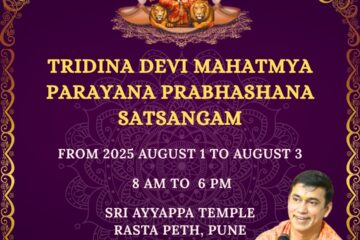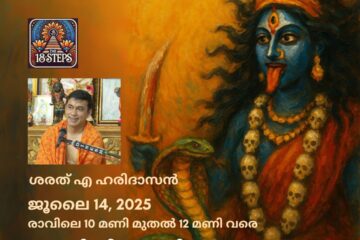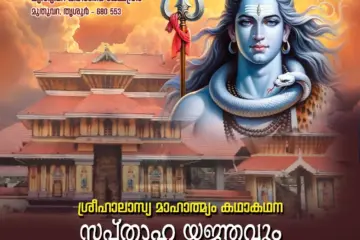by Sharath A Haridasan

On this day, July 31, 2025, the ghats of Varanasi shimmer with devotion. Tulsi Ghat, named after one of India’s most beloved poet-saints, is alive with bhajans, recitations, and lamps floating down the Ganga. Across temples and homes, verses of the Ramcharitmanas and Hanuman Chalisa echo in reverence. For it is the 528th birth anniversary—or jayanti—of Goswami Tulsidas, the sage who not only retold the Ramayana in the voice of the people but also reshaped India’s devotional imagination.
A Saint of the People, For the People
Born Rambola in Rajapur, Uttar Pradesh, in 1497 CE—though scholars still debate the year—Tulsidas entered a world of sharp divisions between the scholarly elite and the common devotee. While Sanskrit texts were the preserve of Brahmins and pandits, Tulsidas wrote in Awadhi, the language of the heartland. By choosing the tongue of the people, he turned the epic of Ramayana into a lived, daily devotion. Through his Ramcharitmanas, Lord Rama was no longer just a divine figure ensconced in the Sanskrit Valmiki Ramayana; he became a friend, a guide, and a moral compass for millions.
A Mythic Childhood, A Mystical Calling
Tulsidas’s early life reads like hagiography infused with faith. According to traditional lore, he was born with a full set of 32 teeth and uttered “Rama” instead of crying. Declared inauspicious, he was abandoned by his parents and raised by a servant named Chuniya until adopted by the sage Narharidas. In Ayodhya, the boy was renamed Tulsidas and immersed in Rama Bhakti. That devotion would burn bright through his life.
A Literary Giant of Bhakti
Between 1574 and 1576, Tulsidas composed the Ramcharitmanas—an epic spanning seven books and over 12,000 verses. In it, he combined the theological gravitas of Vedantic philosophy with the earthy intimacy of vernacular poetry. He called it a manas, a lake of spiritual reflection, where ordinary men and women could bathe their minds.
Tulsidas’s Hanuman Chalisa, a 40-verse hymn to the monkey-god Hanuman, has become one of the most recited spiritual texts in India today—invoked for courage, protection, and inner strength. His other works, including Vinaya Patrika, Kavitavali, and Dohavali, remain staples of devotional literature.
A Cultural Bridge
Tulsidas didn’t just write poems; he sparked a cultural movement. His Ramcharitmanas fueled the rise of Ramlila—dramatic re-enactments of Rama’s life that blend theater, music, and moral education. These performances, especially during Dussehra, continue across India and the diaspora. His verses, set to classical ragas and folk tunes alike, helped crystallize the Bhakti movement’s essence: surrender, love, and devotion over ritual and caste.
Scholars and historians have not hesitated to place Tulsidas in the pantheon of transformative figures. George Grierson called him “the greatest leader of the people after Buddha.” Vincent Smith went further, saying Tulsidas’s influence surpassed that of Emperor Akbar.
Contested Timelines, Unquestioned Legacy
The precise year of Tulsidas’s birth remains a subject of debate. While some propose 1511 CE or even 1532, the current jayanti count—celebrating the 528th anniversary—leans toward 1497 CE, supported by traditional Hindu calendar systems. Regardless of chronology, his impact transcends time.
Living Presence in a Changing World
In modern India, where social media hashtags and news cycles often dictate the spiritual mood, Tulsidas endures. His Ramcharitmanas is taught in classrooms, discussed in parliaments, and recited in slums and palaces alike. The Hanuman Chalisa finds itself on playlists, phone apps, and morning rituals across generations. At Varanasi’s Sankat Mochan Temple, founded by Tulsidas himself, thousands gather even today to seek solace and strength.
This year’s 528th jayanti celebrations are no ordinary commemoration. With grand events in Varanasi—devotional concerts, public readings, and processions—the air is thick with gratitude for a man who gave Rama back to the people. Cultural ministries, spiritual groups, and literary forums have organized seminars, publications, and outreach programs in his honor.
Words That Still Guide Us
In an era fractured by noise and haste, Tulsidas’s message offers stillness and clarity. His vision of Dharma—rooted not in dogma but in compassion, humility, and devotion—feels more urgent than ever. His lines echo not just across temples but in the choices we make each day:
“Dharma ki jai, adharma ka naash, praja ke sukh se bhayo prakaash.”
Victory to righteousness, destruction to evil, let the light shine through the joy of the people.
As India and the world mark Tulsidas Jayanti 2025, the flame he lit centuries ago burns undimmed—a reminder that poetry can become prayer, and that devotion, in the hands of a true poet-saint, can become revolution.



0 Comments